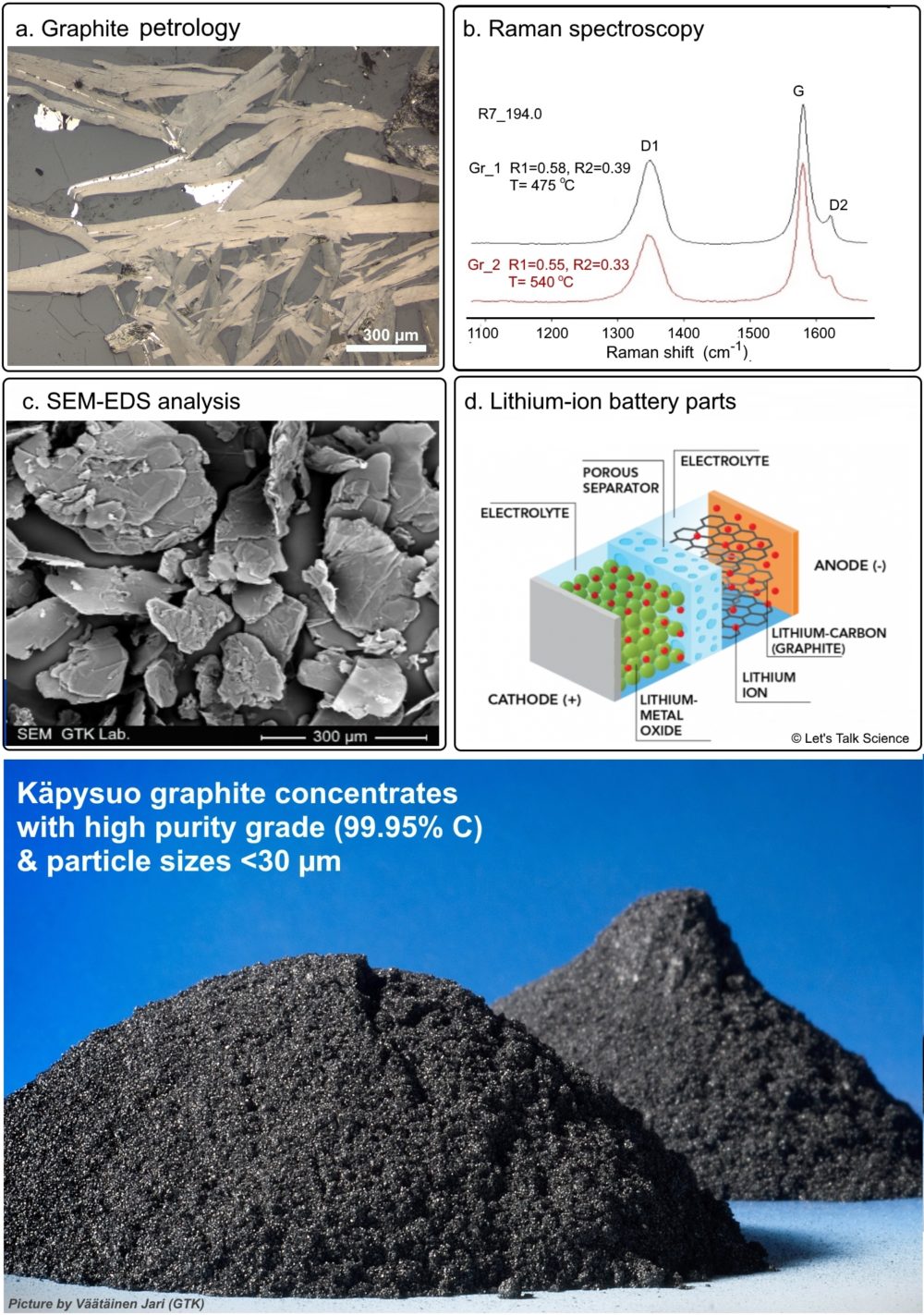Science Blog: Flake Graphite from the High-Grade Metamorphic Savo Schist Belt, Central Finland: Mineralogy and Purification of Graphite as an Anode Material for Li-Ion Batteries
This study relates to GTK’s Battery Mineral Project, 2019–2022, in which the mineral potential evaluation was carried out with an emphasis on flake graphite, cobalt and lithium. Graphite is a form of pure carbon that exists in a simple composition and has a quite simple layered structure. However, natural graphite has been considered as a promising anode material in lithium-ion batteries due to its high reversible capacity, cycle stability, higher purity and more suitable particle-size distribution. The graphitization of carbonaceous material (CM) in high-grade metamorphic terrain at Rautalampi and Käypsuo, which are situated in the Savo Schist Belt of Central Finland, is characterized by the rocks hosting a significant graphite mineralization in mica shist and feldspathic biotite gneiss (Al-Ani et al. 2018 & 2020).
The mineralogical study revealed that the most common morphology of graphite in the Rautalampi and Käypsuo deposits is a flaky-like morphology with strongly foliated schist consisting of alternating biotite, quartz, feldspar, chlorite and sulphides (Fig. 1a). The graphite flakes were found to range in size from 50 to 1600 µm, with the majority being between 200 and 500 µm in length, and the ratios between their long and short axes were in the range of 2 to 5 for most of the flakes. The average grade of the graphite deposits in Rautalampi and Käypsuo was 12.5% carbon with a total sulphur content < 3.0%.
Raman spectroscopy is a simple and fast technique to obtain the degree of crystallinity and the peak metamorphic temperature of graphite. Laser Raman measurements of graphite were carried out by GTK-Mintec using 13 standard thin sections and 6 polished sections of separated graphite flakes from the Rautalampi and Käypsuo deposits. We applied Raman geothermometers with the calibration of Beyssac et al. (2002) and Rahl et al. (2005) to obtain estimates of metamorphic temperatures. According to these calibrations, the formation temperature of ordered graphite flakes in Rautalampi and Käypsuo ranged from 470–600 °C, compared with 400–440 °C for disordered graphite (Fig. 1b). Accordingly, the Rautalampi graphite may have resulted from the transformation of organic matter during metamorphism, most likely no precipitating from carbon-bearing fluids.
Commercial graphite is a relatively expensive industrial mineral, and to obtain natural graphite concentrate with a high quality, beneficiation is essential to obtain optimal prices for finished products. Flaky graphite can easily be purified by flotation due to its high natural hydrophobicity. The average grade of feed samples for flotation processes by GTK-Mintec Laboratories was 12.5% C. Beneficiation using multi-stage grinding and flotation processes increased the graphite grade from 55% to 90% fixed carbon (FC), with recovery ranges between 67% and 83%. The flotation results indicated that the graphite concentrate still contains some mineral impurities, making it difficult to purify using only the typical flotation technique. Quartz and sulphides comprised the majority of the impurity minerals in the investigated graphite ore. Alkaline roasting and acid leaching processes were used to prepare high-purity graphite from a fine graphite concentrate. The results demonstrated that the graphite grade of Rautalampi and Käypsuo ore can be increased to ultra-high purity graphite (99.95% FC) with grinding to a very small particle size of <30 µm, which reaches the requirement for lithium-ion battery production (Fig. 1c). In addition, the high purity graphite product was tested at Kokkola University Consortium, part of the University of Oulu. Test work was directed at the characterization of the high purity graphite and the determination of its suitability for use as an anode material for Li-ion batteries (Fig. 1d).

References
Al-Ani, T., Ahtola, T. & Kuusela, J. 2018. Prospecting and exploration of flake graphite occurrences in Central and Southern Finland, GTK research Report 24/2018. 28 p.
Al-Ani, T., Leinonen, S., Ahtola, T. & Salvador, D. 2020. High-Grade Flake Graphite Deposits in Metamorphic Schist Belt, Central Finland—Mineralogy and Beneficiation of Graphite for Lithium-Ion Battery Applications Minerals 2020, 10(8), 680. Available at: https://doi.org/10.3390/min10080680
Beyssac, O., Goffe, B., Chopin, C. & Rouzaud, J. N. 2002. Raman spectrum of carbonaceous material in metasediments: a new geothermometer. Journal of Metamorphic Geology 20, 859‒871.
Rahl, J., Anderson, K., Brandon, M. & Fassoulas, C. 2005. Raman spectroscopic carbonaceous material thermometry of low-grade metamorphic rocks: calibration and application to tectonic exhumation in Crete, Greece. Earth Planet Sci Lett 240, 339–354.
Text: Thair Al-Ani
Thair Al-Ani completed his Ph.D. in geochemistry and mineralogy at the University of Baghdad in 1996. He has worked as a senior scientist at the Geological Survey of Finland (GTK) since September 2003. Dr Thair Al-Ani has over 14 years of experience of academic teaching at Tripoli University, Libya (1997–2001) and Baghdad University, Iraq (1988–1997). Currently, he is engaged in many projects focusing on GTK strategies relating to graphite, lithium and cobalt as raw materials in lithium-ion battery technologies and other applications for renewable energy.
